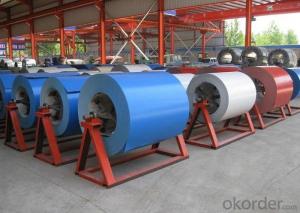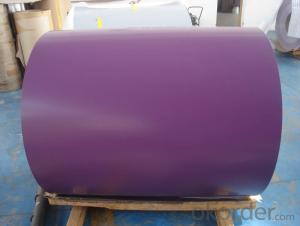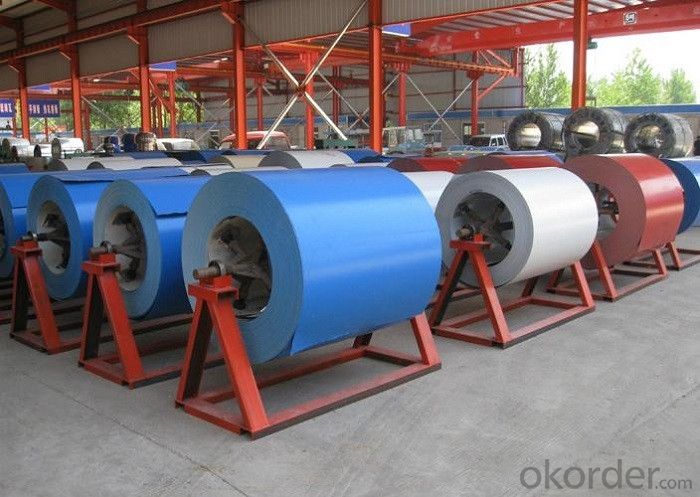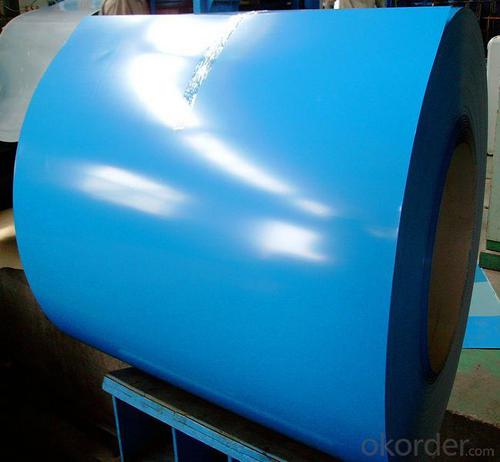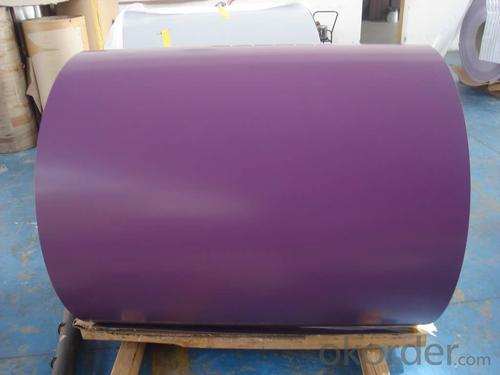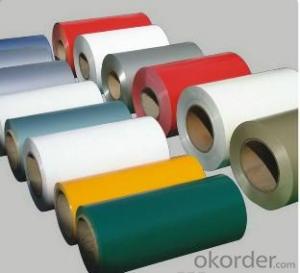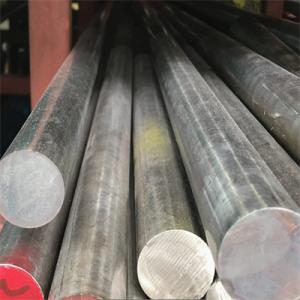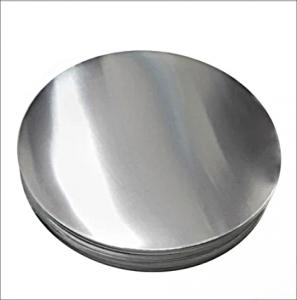Roof Steel Coils - Prepainted Rolled Steel Coil for Construction Roofing Construction
- Loading Port:
- Shanghai
- Payment Terms:
- TT OR LC
- Min Order Qty:
- 50 m.t.
- Supply Capability:
- 30000 m.t./month
OKorder Service Pledge
OKorder Financial Service
You Might Also Like
Structure of Prepainted Rolled steel Coil for Construction Roofing

Description of Prepainted Rolled steel Coil for Construction Roofing
Prepainted Rolled steel Coil is a kind of coated steel coil/sheet. With the cold rolled steel of different strength and thickness as substrate, it is produced through applying Al-Zn coat on both faces by hot dip process. In its coating, Al accounts for about 55%, Si 1.6%, while the remaining is Zn. Aluminum zinc coils enjoys both the physical protective feature and durability of Al and the electrochemical protective property of Zn. And its surface has bright silver color and regular embossed-like figure, which are highly decorative.

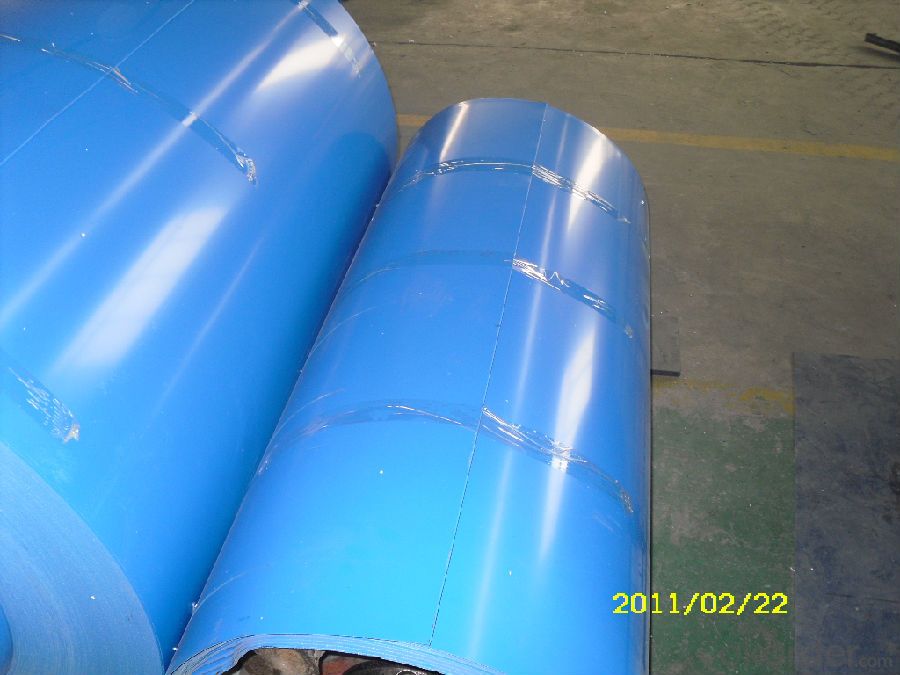
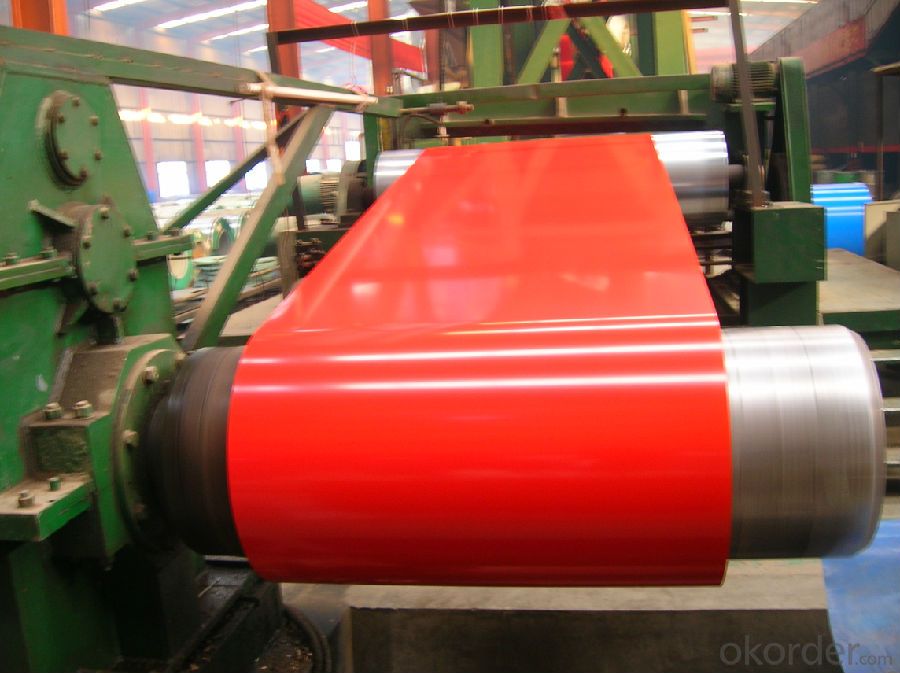
Main Feature of Prepainted Rolled steel Coil for Construction Roofing
1.Corrosion resistance: It mainly depends on the aluminum protection. When the zinc being worn, the aluminum will form a dense layer of aluminum oxide, resist corrosion material to prevent further corrosion inside.
2. Heat resistance: Aluminum zinc alloy steel sheet has excellent heat resistance, can withstand high temperatures over 300 centigrade, and is similar with aluminized steel high temperature oxidation resistance. It often used in chimney pipes, ovens, fluorescent lighting device and the device cover.
3. Heat reflective: Galvanized steel plate heat-reflective high rate is twice as galvanized steel, often used to make insulation materials.
4. Economy: Because density of 55% AL-Zn is smaller than the density of Zn, so in the same weight and thickness of Galvanized zinc layer, aluminum-zinc steel plate is larger area more than 3% of galvanized steel sheet.
Applications of Prepainted Rolled steel Coil for Construction Roofing
1. Construction and building: roofing; ventilating duct; handrail; partition panel;etc.
2. Electric appliance: refrigerator; washing machine; refrigerator; DVD;etc.
3.Transportation: oil tank; road sign; etc.
4.Agriculture:barn; etc.
5.Others:vending machine; game machine; etc.
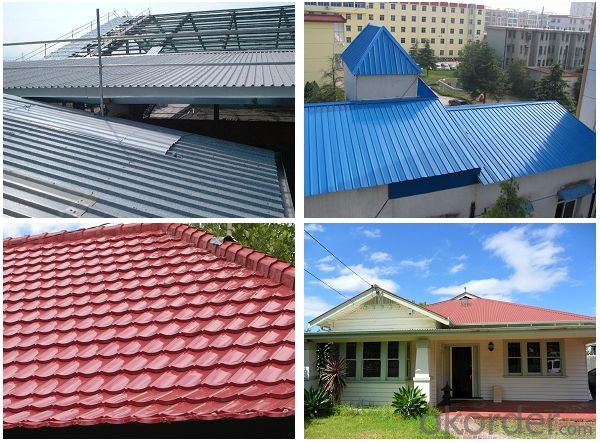
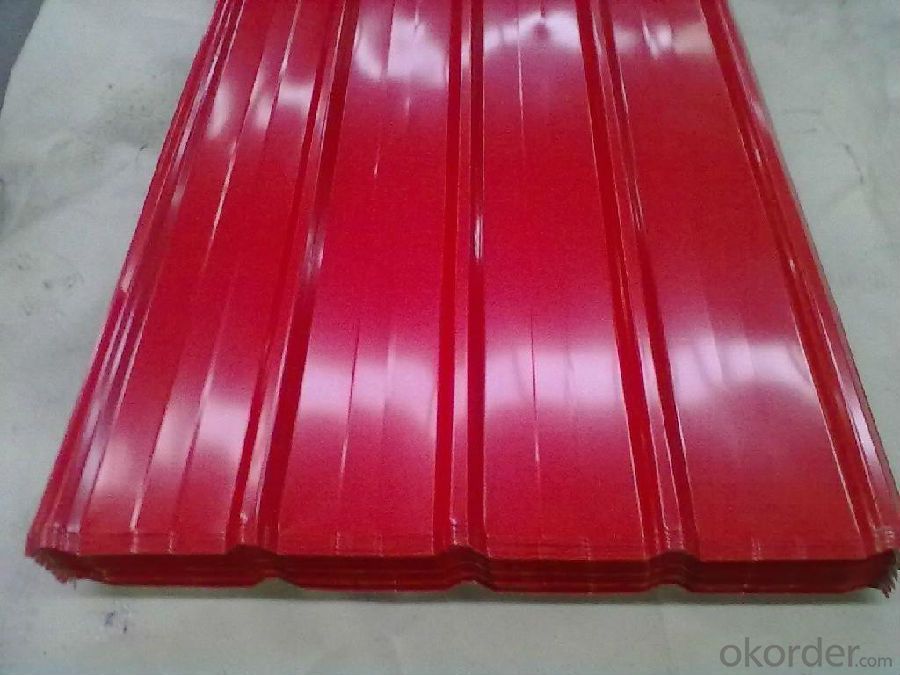
Specifications of Rolled steel Coil for Construction Roofing
Product | Prepainted Rolled steel Coil for Construction Roofing |
Material Grade | SGCC / SGCH / DX51D+AZ, etc |
Thickness | 0.2-3.0mm |
Width | 600-1500mm |
Tolerance | Thickness: +/-0.02mm , Width:+/-2mm |
Zinc-coating | AZ40-150g/m2 |
Technique | Raw material: Hot rolled steel coil --> Cold rolled_>hot dipped galvalume |
Surface | Dried, Chromated, Unoiled |
Spangle | Regular spangle , small spangle, zero spangle |
ID | 508MM |
Coil weight | 10MT max |
Export package | Cardboard inner sleeves, Waterproof paper, galvanized steel covered and steel strip packed |
FAQ of Prepainted Rolled steel Coil for Construction Roofing
We have organized several common questions for our clients,may help you sincerely:
1. What is the minimum order quantity ?
Our MOQ is 50mt for each size. And we will consider to give more discount if you make big order like 1000 tons and more. Further more, the more appropriate payment term your offer the better price we can provide.
2. How long can we receive the product after purchase?
Usually within thirty working days after receiving buyer’s advance payment or LC. We will arrange the factory manufacturing as soon as possible. The cargo readiness usually takes 15-25 days, but the shipment will depend on the vessel situation.
3. How to guarantee the quality of the products?
We have established the international advanced quality management system,every link from raw material to final product we have strict quality test;We resolutely put an end to unqualified products flowing into the market. At the same time, we will provide necessary follow-up service assurance.
- Q:How are steel coils used in construction?
- Steel coils are commonly used in construction for a variety of purposes, such as forming the structural framework of buildings, manufacturing steel beams, and reinforcing concrete structures. The coils are unraveled and shaped into different forms, allowing them to provide strength, stability, and durability to the construction projects.
- Q:were iron age weapons made of steel?
- Even in very early iron, a small amount of steel was produced by carburization, where the iron picks up carbon by laying in hot coals before quenching. This produces a thin layer of steel on the surface of the iron. By about 300 BC Damascus steel was being produced by the crucible method on the Indian subcontinent, and the Romans used steel from Noricum. In the first century BC the Chinese were melting cast iron and wrought iron together to make steel.
- Q:What are the different surface finishes available for steel coils?
- Some of the different surface finishes available for steel coils include hot-dip galvanized, galvannealed, electro-galvanized, and plain.
- Q:I know copper pots are supposed to be really good for cooking with, and I have been looking around online. One thing I don't want to do, however, is send them in to be re-lined with tin. So I was wondering if stainless steel lined copper pots work as well as the traditional tin lined ones, or if those make the copper just for looks.
- Stainless is a fairly poor conductor but that is not why it has hot spots. That's because they tend to be thin. Cast Iron is also a poor conductor and has about the most even heat distribution. Many Copper bottom pots are just Copper plated for looks. In fact only the most expensive will have the heavy Copper bottom needed for even heat. Tin is a metal, an element. Stainless Steel is a mixture ( alloy ) of Iron and Chromium or Nickel or both. I do not know of any cookware that is Tin plated on the inside. I like Aluminium clad Stainless Steel. Good heavy bottom for even heat and Al. is a good conductor. A little more expensive are three layer bottoms. They have the Al. between Stainless so you get the looks and easy cleaning os SS with the heat distribution of Al.
- Q:i see a lot of connexes say repair only with corten steel. what is the difference between corten steel and regular steel. and if i was going to stick weld it what type of electrode would i use?and while i'm at it what is the best electrode to use when welding galvenized steel?
- 6010 and 6011 Electrodes for welding galvenized steel. Weathering steel, best-known under the trademark COR-TEN steel and sometimes written without the hyphen as Corten steel, is a group of steel alloys which were developed to obviate the need for painting, and form a stable rust-like appearance if exposed to the weather for several years. The corrosion-retarding effect of the protective layer is produced by the particular distribution and concentration of alloying elements in it. The layer protecting the surface develops and regenerates continuously when subjected to the influence of the weather. In other words, the steel is allowed to rust in order to form the 'protective' coating. For welding corten steel: 1A.W.S ClassificationE 7018 - 1AWS A 5 - 1 - 78 2IS classificationE 5424 JXIS 814 (Part I II)H 3BS classificationE 51.54 B 12 17HBs 639 - 1976
- Q:What are the different methods of surface inspection for steel coils?
- There are several different methods of surface inspection for steel coils, each with its own advantages and limitations. Some of the most commonly used methods include: 1. Visual Inspection: This is the simplest and most basic method, where an inspector visually examines the surface of the steel coils for any defects such as scratches, dents, or discoloration. While this method is subjective and dependent on the skill and experience of the inspector, it can be a cost-effective option for detecting obvious surface defects. 2. Magnetic Particle Inspection (MPI): This method involves applying a magnetic field to the steel coil and then applying iron particles on the surface. Any defects or cracks in the surface will disrupt the magnetic field, causing the particles to gather at those areas and making the defects visible. MPI is particularly useful for detecting surface cracks and defects that may not be easily visible to the naked eye. 3. Eddy Current Testing (ECT): ECT is a non-destructive testing method that uses electromagnetic induction to detect surface defects on steel coils. A probe with a coil is placed near the surface of the coil, generating an alternating magnetic field. Any changes in the electrical conductivity or magnetic permeability of the steel due to surface defects will cause a change in the induced current, which can be detected and analyzed. ECT is effective for detecting cracks, corrosion, or other surface irregularities. 4. Ultrasonic Testing (UT): This method uses high-frequency sound waves to inspect the surface and subsurface of steel coils. A transducer sends ultrasonic waves into the steel, and the reflected waves are analyzed to detect any changes or anomalies in the material. UT can identify defects such as cracks, delaminations, or voids within the coil, providing valuable information about the overall structural integrity of the steel. 5. Optical Inspection: This method utilizes advanced imaging techniques, such as cameras or laser scanners, to capture high-resolution images of the surface of steel coils. These images can be analyzed for defects, such as scratches, pits, or other irregularities. Optical inspection can provide detailed information and is often used in conjunction with other methods for a comprehensive inspection. It is important to note that each method has its own limitations and may be better suited for specific types of defects or surface conditions. Therefore, a combination of these methods is often employed to ensure a thorough and accurate inspection of steel coils.
- Q:What are the different certifications required for steel coil manufacturers?
- Some of the different certifications required for steel coil manufacturers include ISO 9001, ISO 14001, OHSAS 18001, and various industry-specific certifications such as the American Society for Testing and Materials (ASTM) certifications. These certifications ensure that the steel coil manufacturers meet quality, environmental, and occupational health and safety standards.
- Q:What are the dimensions of steel coils used in the mining equipment industry?
- The dimensions of steel coils used in the mining equipment industry can vary depending on the specific application and requirements. However, there are some common dimensions that are often used. Typically, the width of steel coils used in the mining equipment industry can range from 600mm to 2000mm or even wider. This allows for flexibility in the manufacturing process and ensures that the coils can be tailored to fit various equipment sizes and specifications. In terms of thickness, steel coils used in mining equipment can vary from 1.5mm to 20mm or more. The specific thickness is determined by factors such as the type of equipment, the intended use, and the level of durability required. The length of steel coils used in the mining equipment industry can also vary, but commonly falls within the range of 1000mm to 6000mm. Again, this allows for flexibility in the manufacturing process and ensures that the coils can be cut to fit the specific requirements of the equipment being produced. It is important to note that these dimensions are not set in stone and can be customized to meet the specific needs of the mining equipment industry. Manufacturers and suppliers in the industry are often able to provide coils in various sizes and dimensions to accommodate the diverse range of equipment used in mining operations.
- Q:In pounds per square inch what is the tensile strength of strong steel?
- It is refereed to the ultimate tensile strength which is the point at which the specimen of steel fail (rapture) when subjected to a force,measured by unit force divided by cross section of steel.
- Q:I know that carbon steels and alloy steels are different but are carbon steels still alloys?Thanks!
- Carbon steels are alloys. This is evident in the carbon-iron phase diagram:
1. Manufacturer Overview |
|
|---|---|
| Location | |
| Year Established | |
| Annual Output Value | |
| Main Markets | |
| Company Certifications | |
2. Manufacturer Certificates |
|
|---|---|
| a) Certification Name | |
| Range | |
| Reference | |
| Validity Period | |
3. Manufacturer Capability |
|
|---|---|
| a)Trade Capacity | |
| Nearest Port | |
| Export Percentage | |
| No.of Employees in Trade Department | |
| Language Spoken: | |
| b)Factory Information | |
| Factory Size: | |
| No. of Production Lines | |
| Contract Manufacturing | |
| Product Price Range | |
Send your message to us
Roof Steel Coils - Prepainted Rolled Steel Coil for Construction Roofing Construction
- Loading Port:
- Shanghai
- Payment Terms:
- TT OR LC
- Min Order Qty:
- 50 m.t.
- Supply Capability:
- 30000 m.t./month
OKorder Service Pledge
OKorder Financial Service
Similar products
New products
Hot products
Hot Searches
Related keywords
